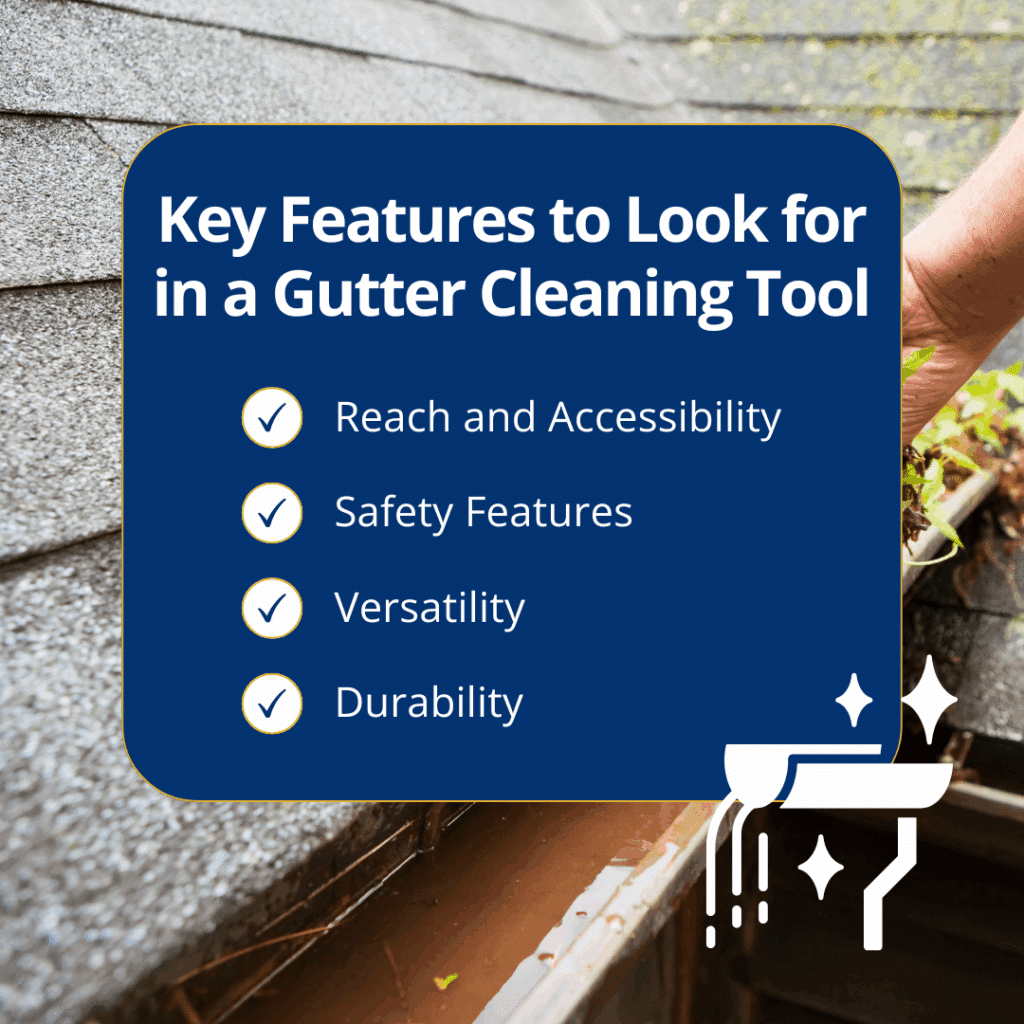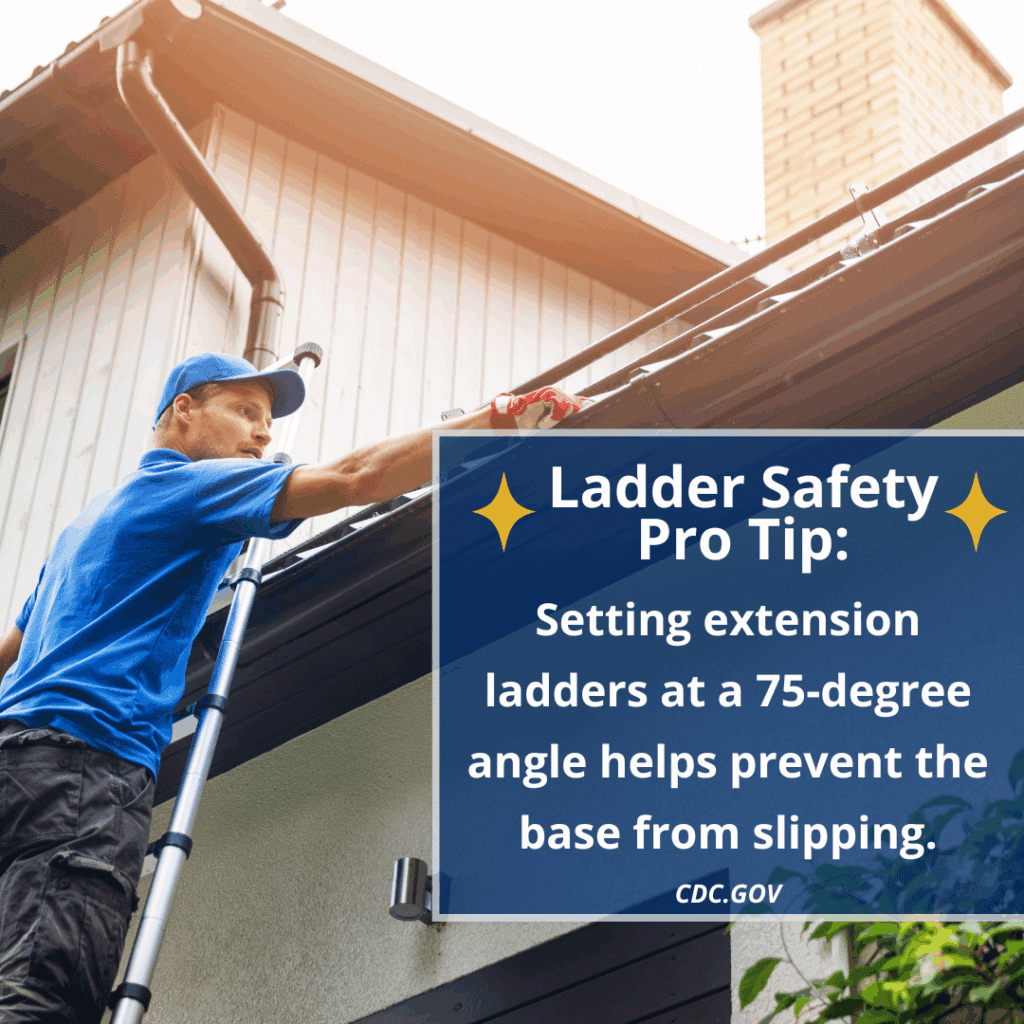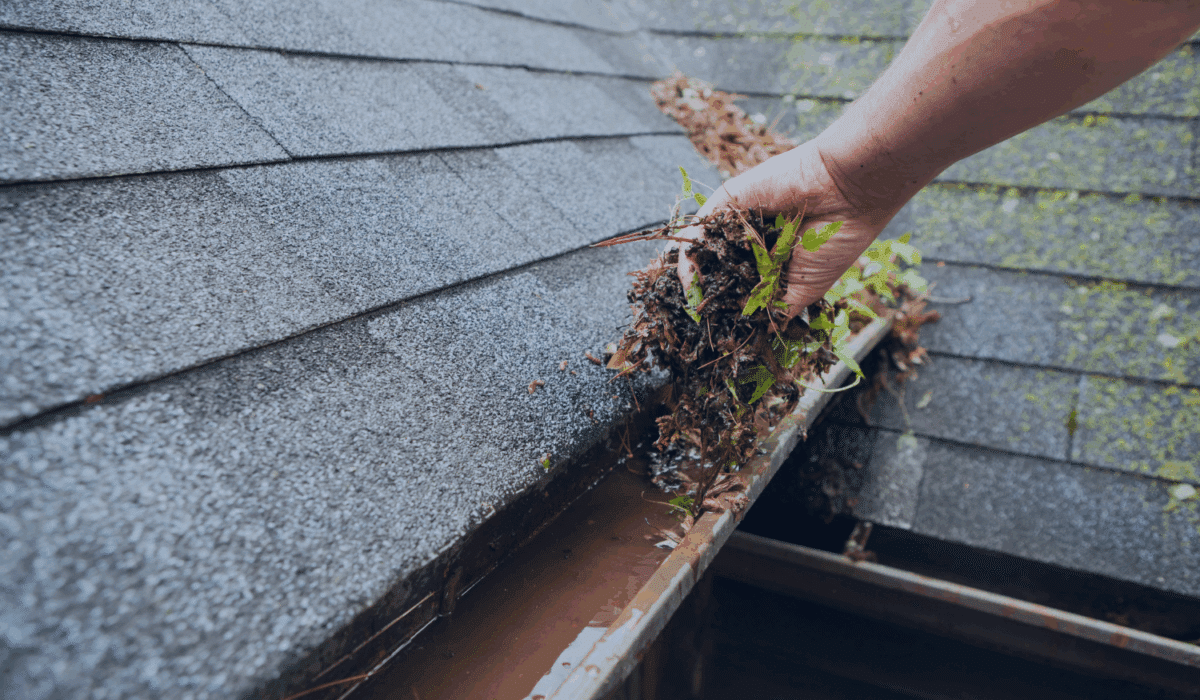Keeping your gutters clean is one of the most important steps in protecting your home from water damage. The best tool for cleaning dirty gutters is usually the one that offers a good balance of safety, ease of use, and effectiveness. For most homeowners, a gutter cleaning wand with an extension pole is the top choice. It allows you to stay safely on the ground while blasting out leaves, mud, and small twigs with a powerful spray of water.
That said, not every home is the same. If you live under heavy tree cover or deal with wet, packed debris, you may need a stronger tool like a shop-vac gutter kit or a pressure washer attachment. And for those who prefer a hands-free approach, robotic gutter cleaners are an option, though they come at a higher price.
In this guide, we’ll cover the most effective tools available, how they work, and what you should consider before choosing the right one for your home.

What to Look For
Choosing the best tool for dirty gutters isn’t just about grabbing the first gadget you see at the hardware store. The right choice depends on your home’s layout, the type of debris you face, and how comfortable you are with ladder use. Here are the key factors to consider:
- Safety: This should always be your top priority. Tools that let you clean from the ground reduce the need for ladders, which lowers the risk of falls. If you do need to climb, make sure you follow ladder safety guidelines. For example, the CDC recommends setting extension ladders at a 75-degree angle, which helps prevent the base from slipping.
- Ease of use: Look for tools that are simple to set up and operate. Telescoping poles, adjustable nozzles, and lightweight materials make cleaning easier.
- Effectiveness: Make sure the tool matches the type of debris you usually find. Some tools work better for dry leaves, while others handle wet sludge or pine needles.
- Reach: Your gutter tool should extend far enough to reach the highest sections of your home without forcing you to stretch dangerously.
- Durability and cost: Higher-quality tools made from aluminum, brass, or reinforced plastic will last longer. It may be worth paying more upfront for something that won’t break after one season.
- Cleanup impact: Consider where the debris will go. Some tools push leaves to the ground, while others vacuum debris directly, keeping your yard cleaner.
By keeping these factors in mind, you’ll be able to choose a tool that saves you both time and money while keeping your home safe.
Tools for Cleaning Dirty Gutters
Now that you know what to look for, let’s dive into the most common gutter cleaning tools, how they work, and what situations they’re best suited for.
1) Gutter Scoops and Cleaning Spoons
A gutter scoop is the simplest and most affordable tool for cleaning dirty gutters. It’s basically a shaped plastic or metal scoop that fits inside the gutter channel.
- Best for: Smaller homes, light debris, and homeowners who don’t mind climbing a ladder.
- Pros: Very inexpensive, durable, and easy to use.
- Cons: Requires climbing a ladder, slower for large homes, and messier.
How to use: Place your ladder on stable ground and climb to gutter level. Wear gloves to protect your hands, then scoop debris into a bucket. Once the gutter is clear, flush it with a garden hose to make sure the downspouts are open.
Extra tip: Place a tarp under your work area to collect falling debris and save yourself from cleanup later.
2) Gutter Cleaning Wands and Extension Kits
These tools attach to your garden hose and use high-pressure water to blast debris out of the gutters. Many models have adjustable nozzles that let you angle the spray directly into the gutter without climbing a ladder.
- Best for: Most homeowners who want a safe, affordable, and effective solution.
- Pros: Keeps you on the ground, fast, and adjustable for different gutter angles.
- Cons: Can splash water and debris onto your yard or siding, less effective on packed mud.
How to use: Connect the wand to your hose, set the spray pressure, and start at the end of the gutter farthest from the downspout. Work slowly toward the downspout, pushing debris along the way. Once finished, check that water flows smoothly out of the spout.
3) Wet/Dry Shop-Vac Gutter Attachments
If you own a wet/dry shop vacuum, a gutter cleaning kit can transform it into a powerful tool for removing wet leaves and sludge. These attachments are long, curved tubes that let you reach into gutters from the ground.
- Best for: Heavier debris like mud, pine needles, and wet leaves.
- Pros: Strong suction, keeps your yard cleaner by containing debris.
- Cons: Can be heavy to maneuver, attachments may cost extra, and you’ll need an outdoor-rated extension cord.
How to use: Attach the gutter kit to your shop vac, position the tube inside the gutter, and slowly move along the line. Empty the vacuum canister as needed to maintain suction. For easier cleanup, line the canister with a trash bag before starting.
4) Leaf Blowers with Gutter Attachments
If you already own a leaf blower, you may be able to add a gutter kit to push dry leaves out of your gutters. These kits usually include long tubes that connect to your blower and bend into the gutter.
- Best for: Quick fall cleanups when leaves are dry and loose.
- Pros: Fast, efficient, and works without water or heavy lifting.
- Cons: Ineffective on wet or packed debris, can scatter leaves all over your yard.
How to use: Only attempt this method on dry days. Start at one end of the gutter and blow leaves toward the downspout. Finish with a hose rinse to remove any leftover dirt or small twigs.
5) Pressure Washer Attachments
For homes with stubborn dirt and packed debris, a pressure washer can be fitted with a U-shaped gutter attachment. This tool uses high-pressure water to blast everything out of the trough.
- Best for: Gutters with packed mud, thick layers of dirt, or long-term neglect.
- Pros: Extremely powerful, works quickly, and clears tough buildup.
- Cons: Can be messy, uses a lot of water, and may damage gutters or siding if the pressure is too high.
How to use: Start with low pressure and increase gradually. Keep the wand moving at all times to avoid damaging shingles or seams. Always wear eye protection and cover nearby plants before starting.
6) Robotic Gutter Cleaners
Robotic gutter cleaners are small, motorized devices that crawl through your gutters, breaking up and pushing debris out as they go. While they’re more expensive, they’re also the most hands-free option available.
- Best for: Large homes with multiple stories and homeowners who want to avoid manual cleaning.
- Pros: Requires little effort, reduces ladder use, and can save time.
- Cons: High cost, may not clean corners thoroughly, and still requires occasional supervision.
How to use: Place the robot inside a clear section of the gutter, use the remote to guide it, and let it run along the channel. You may still need to manually clean stubborn spots.

Safety Tips When You Clean Gutters
Even with the best tool, safety should come first. Ladder falls are one of the leading causes of home maintenance injuries. To stay safe:
- Always use a sturdy ladder if climbing. Follow the 75-degree rule to keep it stable.
- Wear gloves to protect your hands from sharp twigs or screws.
- Put on safety glasses to shield your eyes from flying debris.
- Only clean gutters in dry weather. Wet surfaces increase the risk of slipping.
- Keep kids and pets away from your work zone.
- If you’re using water-powered tools, avoid working near power lines or electrical outlets.
How Often Should You Clean Gutters?
Most homes need gutter cleaning twice a year, once in the spring and once in the fall. If you live under heavy tree cover, you may need to do it more often. Pine needles, in particular, can clog gutters quickly and should be cleared before they form mats.
Water damage is one of the most common and costly insurance claims in U.S. homes, with average repair costs running into the thousands. By cleaning regularly with the right tool, you prevent overflow, protect your foundation, and extend the life of your roof and siding.
Other Helpful Home Maintenance Tips
While regular cleaning is essential, there are a few extra steps that can make gutter upkeep easier:
- Install gutter guards: Micro-mesh guards can block most debris, reducing how often you need to clean.
- Trim nearby trees: This cuts down on the number of leaves and twigs that fall into your gutters.
- Check downspouts: Make sure water is flowing freely away from your foundation. Add extensions if needed.
- Inspect your gutters: Look for sagging, leaks, or rust spots during cleanings. Early fixes prevent big repairs later.
Related Questions
Can I clean gutters without a ladder?
Yes. Many gutter wands and vacuum attachments let you clean from the ground, even on two-story homes.
What’s the fastest way to clean dirty gutters?
A leaf blower attachment is the quickest for dry leaves, while a pressure washer or vacuum is faster to unclog wet debris.
Do gutter guards mean I’ll never have to clean again?
No. Gutter guards reduce how often you’ll need to clean, but you should still check gutters at least once a year.
How do I know if my gutters are clear?
During a rainstorm, watch your downspouts. If water flows smoothly and doesn’t spill over the sides, your gutters are clear.
Conclusion
Finding the best tool for cleaning dirty gutters comes down to your home’s needs. For most people, a gutter cleaning wand with an extension kit is the most versatile and cost-effective option. For heavy debris, a shop-vac kit or pressure washer attachment can provide extra cleaning power. No matter what you choose, cleaning your gutters regularly will help you avoid expensive water damage and keep your home in good shape year-round.
At Edifice Inspections, we know that small maintenance steps, like keeping your gutters clean, prevent big repair bills later. During our home inspections, we pay close attention to the condition of your gutters, downspouts, and drainage systems so you have a clear picture of your home’s overall health.


2 Comments
Comments are closed.